Making tonkotsu ramen at home is truly a labour of love. This isn’t some 15 minute miracle insta-ramen recipe. This isn’t even some one day recipe.
Making authentic tonkotsu ramen takes time. It takes effort. You have to be a bit crazy to go there. But it’s so good. It’s totally worth it.
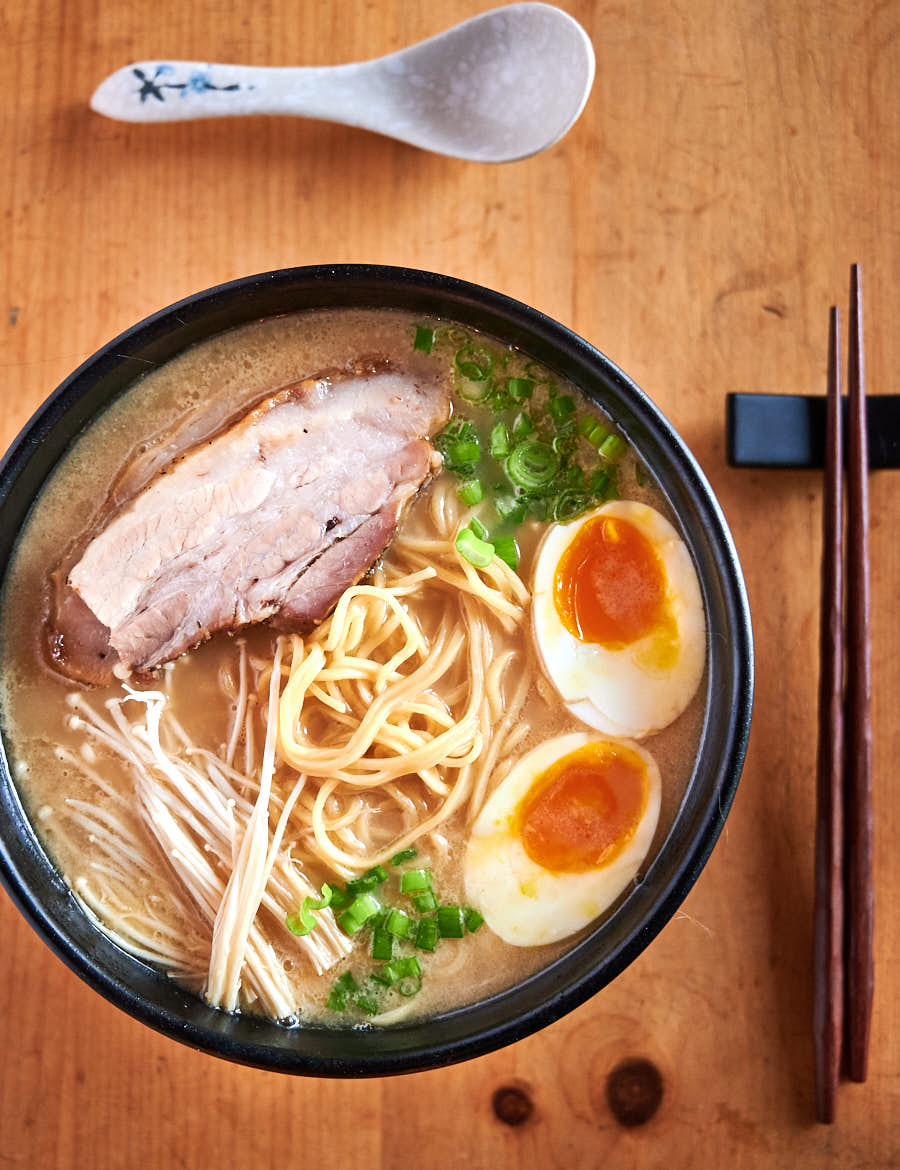
There are restaurants in Japan that do nothing but make tonkotsu ramen. Just big wonderful pots of the most amazing broth. Perfect noodles. Silky eggs and unbelievable pork. I’ve had it. And I love it.
This recipe may not quite hit the level of Japanese ramen making. People have devoted their whole lives to mastering the art. But it’s pretty damn good. And it’s way cheaper than a plane ticket to Narita.
There are five major ingredients
Tonkotsu ramen has five major ingredients. Broth. Noodles. Pork. Egg. Tare. Each is important and each takes some doing.
Tonkotsu broth is the heart and soul of any tonkotsu ramen. It’s not difficult but it takes time – 12 to 18 hours. Mostly unattended but you can’t rush this. You can make lots and freeze it though. Two bowls or twenty. Doesn’t matter at all as long as you have a big enough pot.
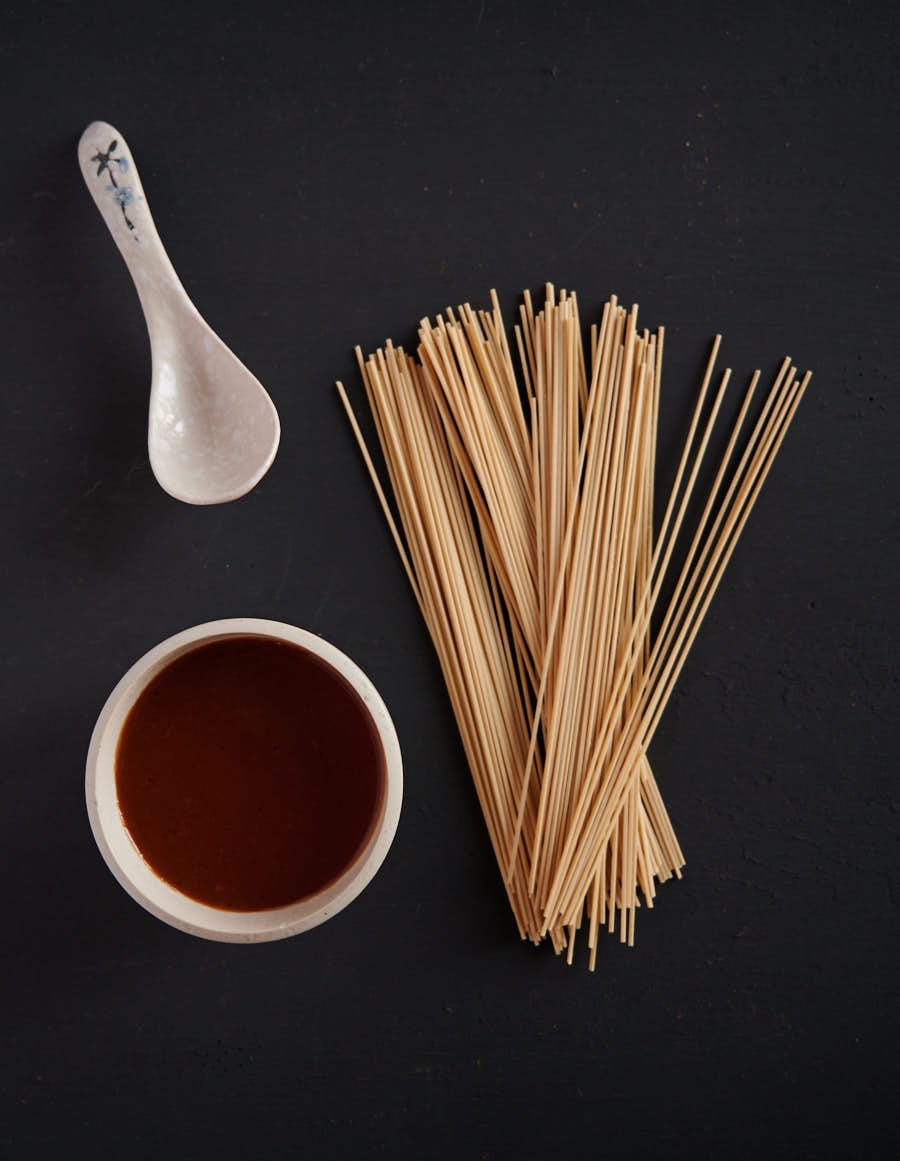
The noodles are key
The noodles are the backbone. Noodles were where I struggled the most. The fresh ramen I can get in town sucks. Like really sucks.
Ramen noodles are different. They are alkalinated. That’s a fancy way of saying you put baking soda in the dough. Asian stores sell dried Japanese ramen. Look for sodium carbonate or potassium carbonate in the ingredient list.
If you can’t find any, another trick is to boil spaghettini or capellini in 8 cups of water with 2 Tbsp of baking soda. That works too.
Please don’t use packaged dry instant ramen noodles. Those are completely different. I like them in an I like KFC sort of way (as in I eat it once every few years and then wonder why I did that) but for this they are so wrong…
The pork is called chashu. It’s marinated pork belly and it’s magic stuff. I do mine sous vide for 11 hours at 170F. Conventionally cooked chashu recipes are all over the internet.
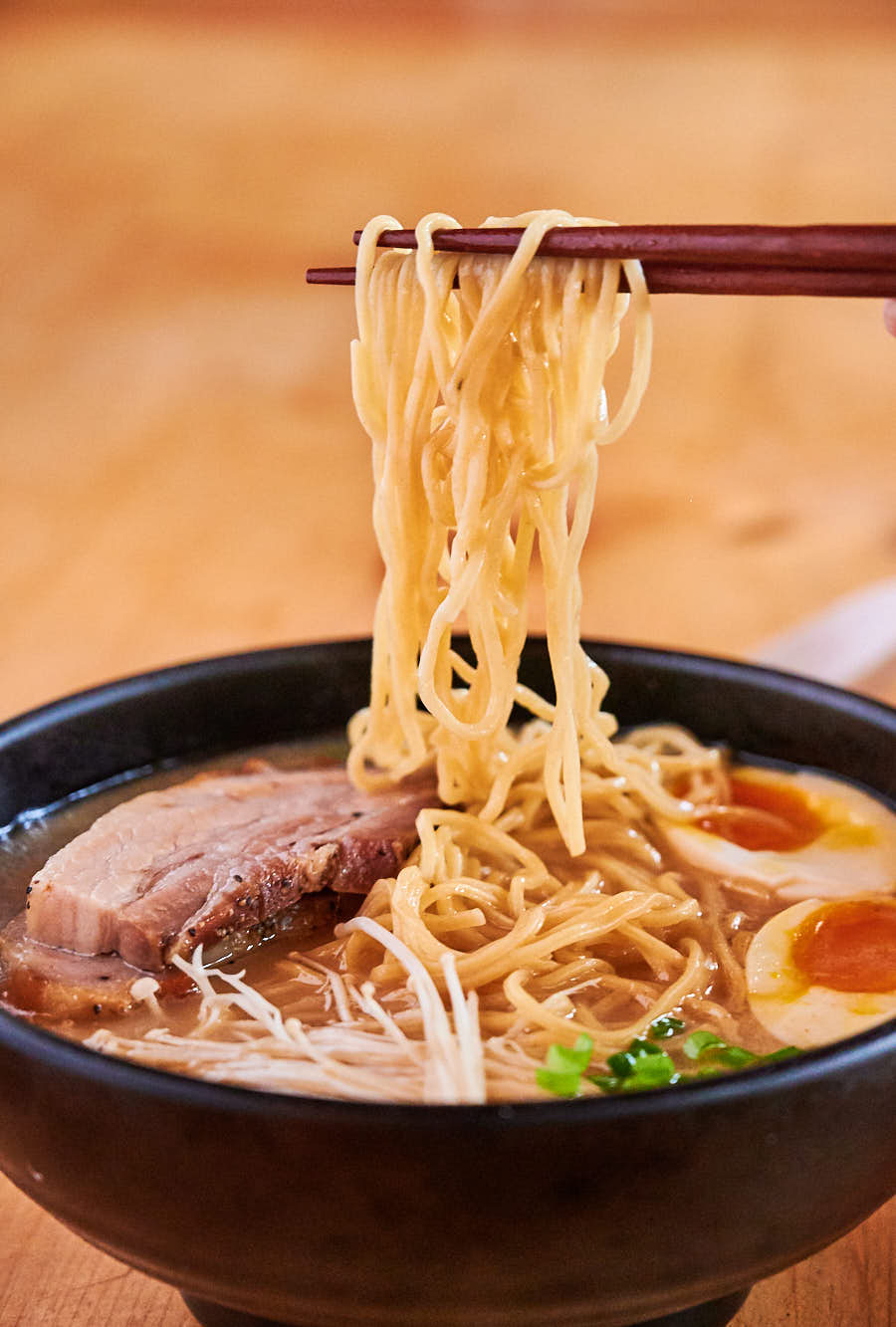
The eggs and the seasoning
Tonkotsu ramen is usually served with medium boiled eggs. I didn’t even know there was such a thing as medium boiled egg until I discovered ramen. Medium boiled is about a 7 minute egg. The whites are firm. The yolk are just barely set. Just so good.
The tare is the flavour base. This is where you take your ramen in your direction. It can be as simple as salt or as complicated as bacon infused sweet soy miso tare. Up to you.
Pull these 5 elements together and you have wonder in a bowl. If you don’t understand why you’re reading this and think I’m crazy google the best ramen joint in your town.
Go taste for yourself. Then judge me. It may seem daunting but it’s a few manageable steps. Totally doable if you want it bad enough.
This is adapted from several recipes from the internet. The soy bacon tare is a based on David Chang’s Momofuku Tare 2.0. The chashu pork marinade is from Serious Eats. The tonkotsu ramen broth is the best of a bunch of recipes on the net.
Tonkotsu ramen. It’s real work. But it is so worth it.
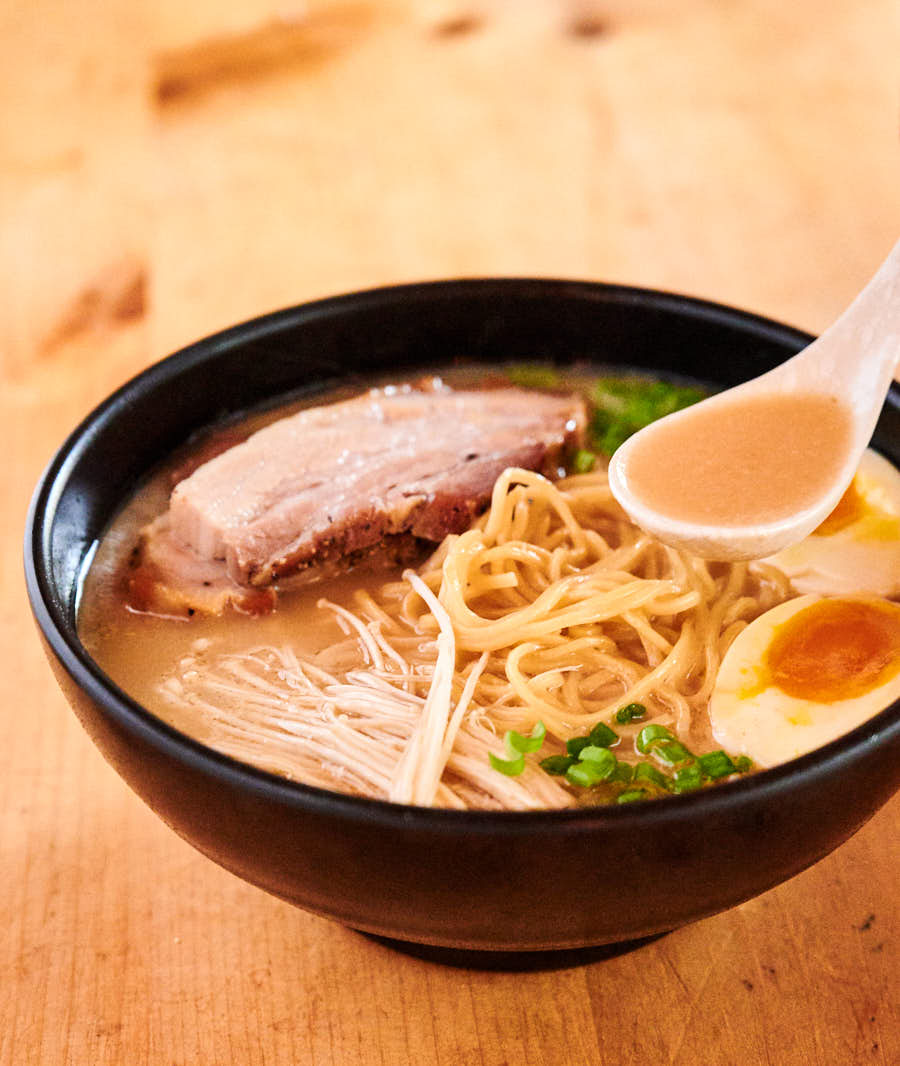
Update: Since I wrote this post I learned how to make Momofuku pork belly. If you’re interested I actually got a lesson in the kitchen at Momofuku Las Vegas. So I’m pretty sure it’s the real deal.
I still love the sous vide chashu pork belly and make it regularly. But the Momofuku pork belly is really good too. And you don’t need a sous vide to make it.
I’ve taken new pictures since this was first published. The new pictures have the Momofuku pork belly in them. So if you make chashu pork don’t be alarmed if it looks different. It is different. I cannot decide which one I like better.
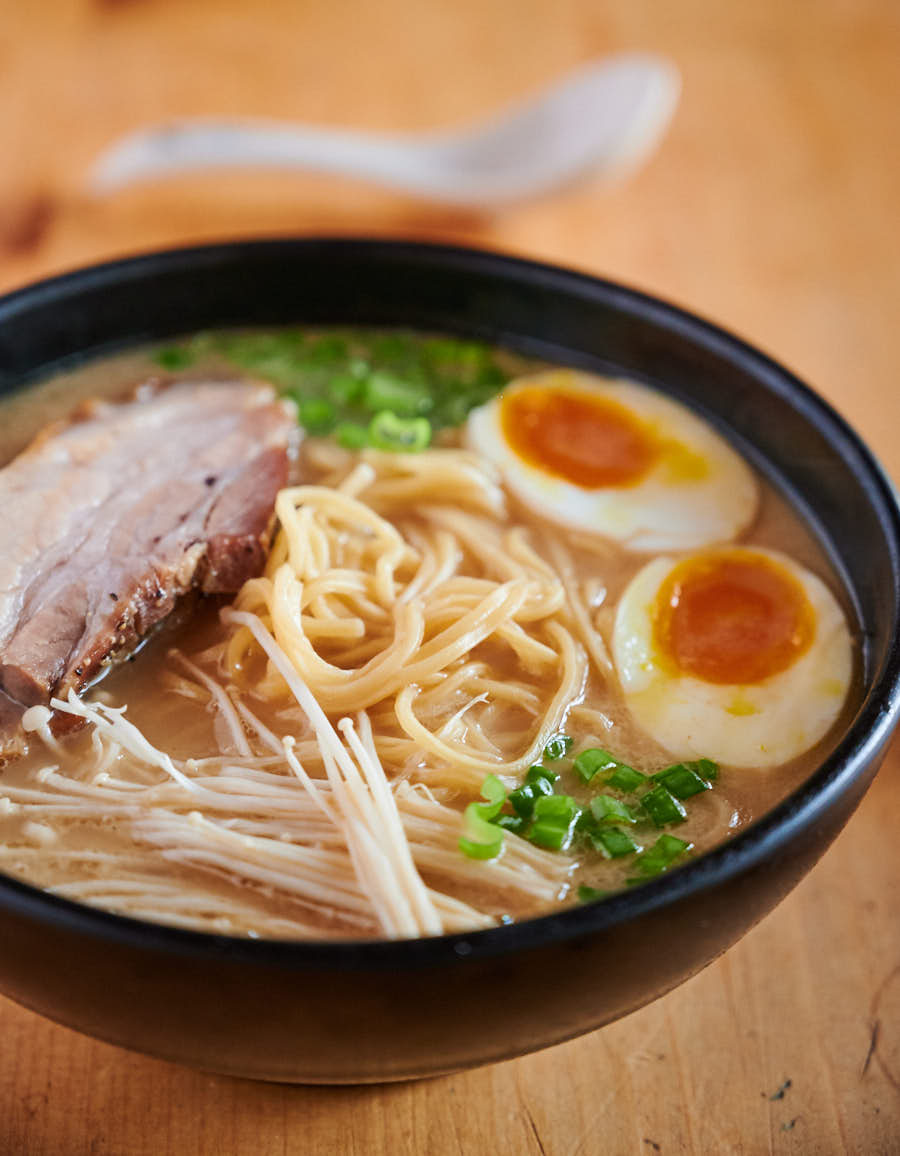
tonkotsu ramen
Ingredients
Tonkotsu ramen
- 8 cups tonkotsu pork broth – recipe link below
- 12 oz good quality dried ramen noodles
- 4 large or extra large eggs
- 2-3 oz enoki or other mushrooms
- thinly sliced green onions
Chashu pork belly
- 2 lb pork belly – rolled and tied
- 1/4 cup soy sauce
- 1/2 cup sake
- 1/2 cup mirin – sweet Japanese wine
- 1/4 cup sugar
- 2-3 cloves garlic – left whole
- 2 green onions – coarsely chopped
Soy bacon tare
- 2 slices bacon – use good quality bacon here
- 1/4 cup soy sauce
- 2 Tbsp mirin
- 2 Tbsp sake
- 4 Tbsp shiro miso
Miso Tare
- 1/2 cup shiro miso
- 1/4 cup sake
- 1/4 cup mirin
- pinch shichimi togarashi (optional)
- 1-2 tsp kosher salt – depending on how salty you like your ramen.
Instructions
Chashu pork belly
- Combine the soy, sake, mirin, sugar, garlic and green onions in a ziploc bag large enough to hold the pork belly. Stick a straw in the bag and seal the ziploc bag up against it (so the straw is the only opening). Suck as much of the air out as you can and seal.
- Sous vide the pork for 10-11 hours at 170F.
- Remove pork from the ziploc bag. Discard the bag and marinade.
- Let the chashu pork belly cool completely.
- Slice across the chashu pork (so you get bacon like slices) – into 8-12 slices about 1/8 to 3/16 inches thick. Reserve. You won’t need all the pork for 4 servings.
Soy bacon tare
- Combine all the ingredients in a small sauce pan. Simmer at the lowest setting for about an hour. Top up with a bit of chicken stock if needed.
- Remove the bacon.
Miso tare
- Combine all ingredients in a small sauce pan and simmer at the lowest setting for about 5 minutes.
Medium boiled eggs
- Bring enough water to cover the eggs to a boil. If you have a way to prick the eggshell do it. Boil large eggs for 6 minutes 30 seconds. If using extra large eggs boil them for 7 minutes 30 seconds. You may have to adjust your times slightly depending on the exact size of your eggs but this should get you pretty close.
- Submerge the eggs in cold or ice water to chill. This stops the egg yolks from continuing to set up. Peel. Cut in half right before you serve your tonkotsu ramen.
Assemble the tonkotsu ramen
- Boil the ramen noodles in plenty of water as directed by the packaging. If there’s no translation on the packaging usually its 4 minutes. You don’t need to salt the water.
- Cook the mushrooms along side the noodles – you just want them softened.
- Gently fry the chashu pork in a non-stick skillet until lightly browned.
- Place 1/4 of whichever tare you are using in the bottom of four bowls.
- Ladle in about 1/2 cup of the tonkotsu broth into each of the bowls and stir to mix.
- Add the noodles. Pour in another 1 1/2 cups of the tonkotsu broth per bowl.
- Top with the egg, mushrooms, pork and green onions.
Notes
Nutrition
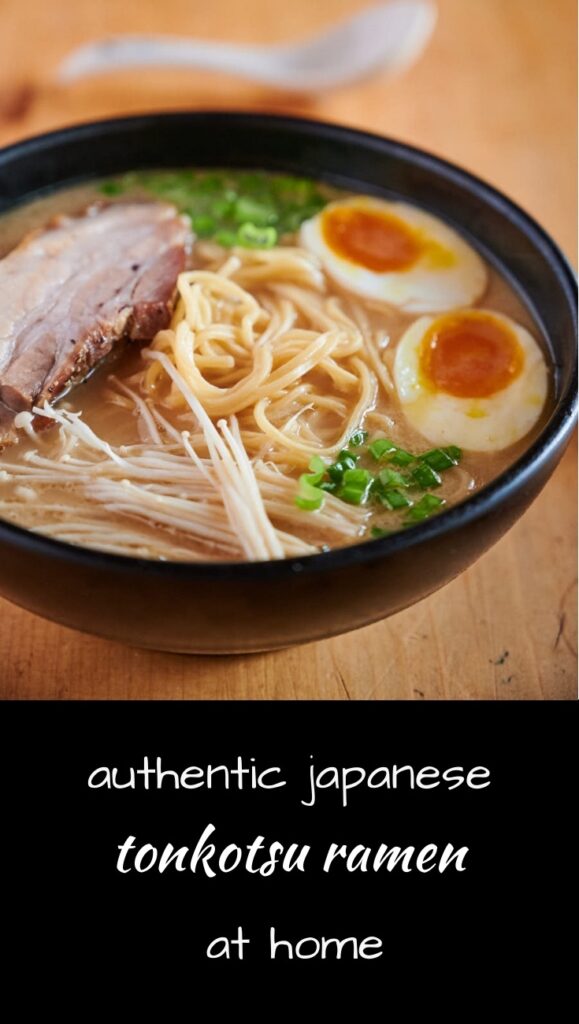

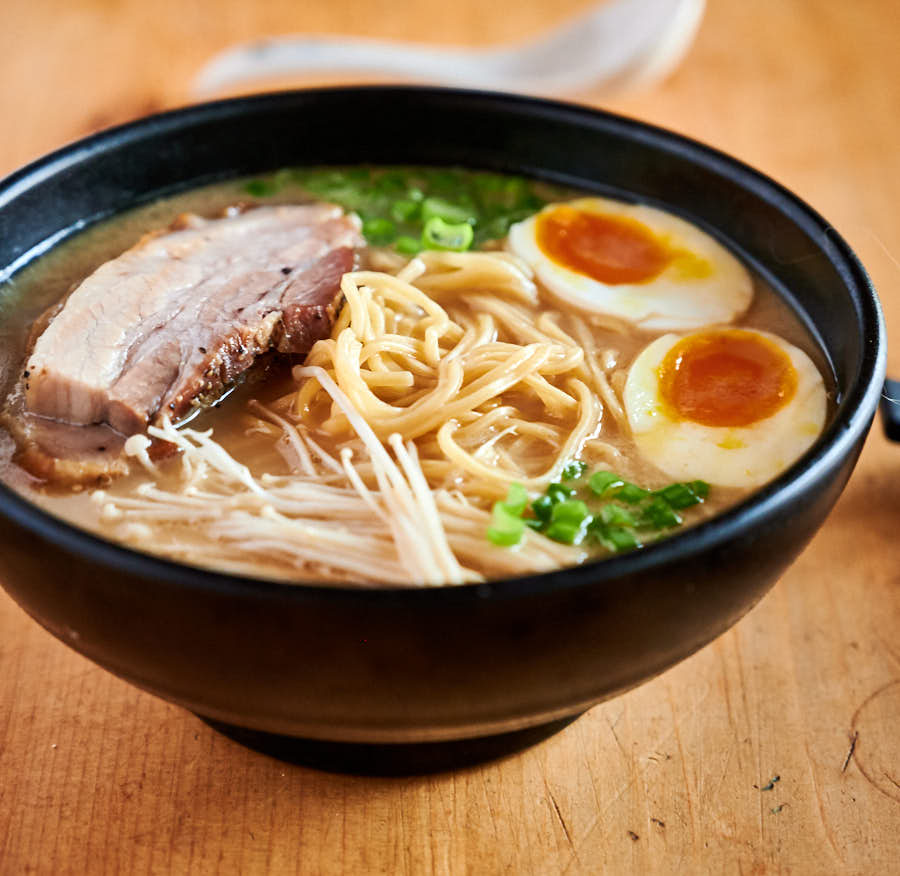
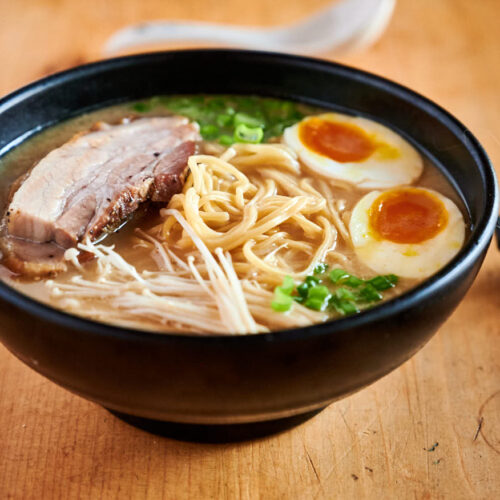
I had try, but the soup base is brown in color, not the white creamy color, is because the fried onion had cause it?
Sorry, I don’t understand. What fried onions are you referring to?
This recipe looks great! I can’t wait to try it. I was wondering though if additional water needs to be added to the soup base before serving with the ramen or is the base served as is? Thank you a lot
If you follow the recipe and getting 8 cups of broth then no dilution is required.
I love this recipe very much. I followed your recipe, then I had a great meal. Thank you very much. This dish is both nutritious and delicious. I will make this for parties.
It’s a fair bit of work but the results are so worth it! Glad you liked it.
I jUst made it two days ago, it as realy good! I’m so impressed with your recipe ? I made it last Tuesday and heated it up tonight, the soup and chasu pork taste so much better!! I can’t fine sake here in Melbourne, so I only used chinese cooking wine instead, it turned out awesome ? ?
It’s a lot of work but it’s so worth it!
I have a question about the water ratio, mainly because Im trying to be super lazy / go do other things. If I have a giant soup pot and can fill it well above the bones, can I add extra water so I dont have to check it as often? Would this somehow dilute the ultimate product or increase the cook time?
I’ve never tried it but so long as you can maintain a rolling boil with your giant soup pot and reduce it appropriately at the end it should work…
Roast the pork right before tasting will be so perfect. Thank you much!
In spite of having not enough ingredients but it came out so well I think. I and my wife usually follow the recipe on internet and follow. You are one of favorite one she loves.
Great to hear you enjoyed it!
Bro this was the most legit Ramen I’ve had in ages. 3day cook for me but oh so worth it. Devoured in 3 mins!! Thanks for the inspiration and detailed instructions
Glad you liked it. 3 days work for 3 minutes of bliss. Totally worth it!
Hey, thank you for putting this up. We made it for birthday (today) and it totally worked. We did 2 separate batches simultaneously, one following your recipe, the other the exact same but w beef bones. I’ve had a bowl of the pork broth w momofuku pork belly and a tahini/ginger tare I threw together and its great, better than anything I can get locally for sure.
I’m not sure how the beef batch will be. its milky but I don’t think it has the same amount of dissolved gelatin so probably won’t be as flavorful. Also made your miso tare which I will eat in the next bowl. Anyway thanks again
Happy Birthday! Glad you liked it.
Very excited to try this, going to start early tomorrow morning. My only question is about the pork belly, I saw in another comment you said it was already sliced. The pieces I have are about regular bacon sized except for thickness. They’re about 10 inches long? 1.5 – 2 inches wide, and 2 inches thick. I have 3 of them. Is that about right? Or do you have a whole slab that you later cut down? Wish you had pictures!
I cook the pork belly in slabs, then slice. You should be OK with your pieces as they are.
I like this recipe I think I will try it myself
Great!
What is Shiro Miso? Would you use a specific color miso?
Shiro miso is white miso.
Hello Romain
I want to ask a few questions. When you fry the chasiu, did you slice it first then fry?
For the soy bacon tare, what kind of bacon did you use? is it okay to use streaky bacon?
And for sake, i use cooking sake. Will it make the taste different rather than using alcohol sake?
Haha. Your questions made me google two things. Yes, the chashu is sliced, then fried. I knew that:-)
I use streaky bacon. That’s just called bacon in Canada despite what the world thinks. Had to google streaky bacon.
I didn’t even know cooking sake existed. Seems it has a lot of salt in it. That will change the salt balance of the tare so be careful. This one is tricky. You can’t just taste the tare for salt as it is what seasons the broth. If you use going to use cooking sake I’d add a little less tare and creep up on it. It would be a horrible shame to overseason after going through all this work.
Or, if you can, just use regular sake and keep the bottle to cook. That’s what I do.
Hello Romain!
After trying out your excellent Indian curries, i’ll be making tonkotsu broth from your blog this week-end. My butcher gave me mostly trotters and jawbones, from happy pigs. First timer, so hopefully it’ll turn out good.
I have a question regarding tare – I was going to braisé my chashu with sake, soy, green onion and mirin, a different method than your oven shashu. Can I simply use my strained braisé chashu liquid for tare (with additional shiro miso)?
Keep up with the great recipes!
Hello Lauren!
So glad you like the curries.
I don’t know what your broth will taste like in the end so it’s hard for me to say whether it will work. You may want to defat it a bit and then try concentrating it down to intensify the flavour. Remember that it gets diluted by the tonkotsu broth. Maybe try a bit of your tare in a bit of broth, see how that works and refine as needed. Better that you try it out ahead of time I think.
Ultimately, it will be about the salt – you want the salt to be in balance in the final broth. You will need to feel your way along a bit but I’m guessing you will wind up with a great bowl of ramen.
I was in Naha, Okinawa in November 2019 where friends & I discovered the ramen restaurants there. Oh man, I am hooked. Thank you for the recipes. I am cooking the broth right now and my kitchen smells just like the ramen joints I remember.
Love it!
Spicy question!
I made this. Absolutely phenomenal. I spent my birthday by myself being quarantined, so 12 hour broth was a great option. I used your bacon tare recipe, and also made the momofuku pork you provided and just wow. In your opinion since I have full trust in you, what would you do/use to make this spicy? I put spice in the tare? Would love a response from you instead of googling
Happy birthday! So glad you liked everything. Would have been doubly sad if you had been disappointed.
If I ever decide to take any of my precious tonkotsu stock and spice it up I will make this – https://staging2.glebekitchen.com/korean-ramen/
Swap out the chicken for some leftover momofuku pork belly and I think I would be in heaven.
With all the self-isolation and staying at home, I think now is the perfect time to give this a try. What’s your preferred method for heating up the broth when it’s time to serve? I figure I’ll make the broth and sous vide the chashu the day before and refrigerate, and cook the noodles and tare the day of. Chashu pork will be pan fried to brown it and warm it up, but what to do with the broth? Bring it back to a quick boil on the stove before serving?
Sounds like a solid plan to me. So long as the broth is good and hot you should be good to go!
Hi there. Awesome recipe and pictures. Do you have an e-mail where I can contact you? I have a question regarding the pictures.
Thank you for saying so. I’ve sent you an email.
I’m a little confused. Aren’t technically sake and Mirin the same thing? The bottle of mirin that I have says sweetened sake on it. Do you specifically meant the alcohol sake?
Yes. I mean the alcohol sake. It typically has higher alcohol content and much less sugar than mirin.
It is just me, so I am looking to make this and freeze each component. How is the pork when it is frozen and defrosted in individual servings? Can I put the broth in with the Tare and freeze (like in individual mason jars)? I am currently making the tonkotsu broth 🙂
I do freeze the broth in portions so I know that works. I have never tried to freeze the pork or the tare though. I imagine the tare would be fine. If you cryovac (foodsaver) the pork would think it would be OK but I don’t know this for a fact I am afraid.
I am so glad I went through all the work to make this. Soooo rewarding and so good. Totally worth the effort!!!!
You just can’t take shortcuts sometimes. This one is epic but it’s worth it!